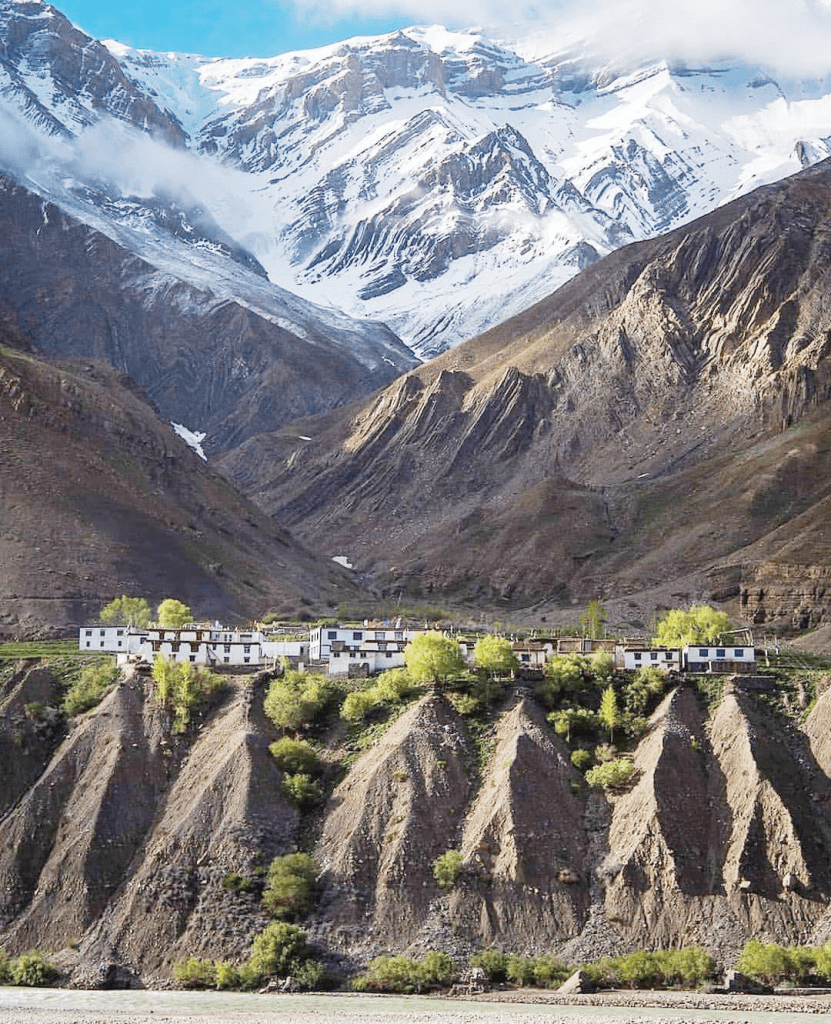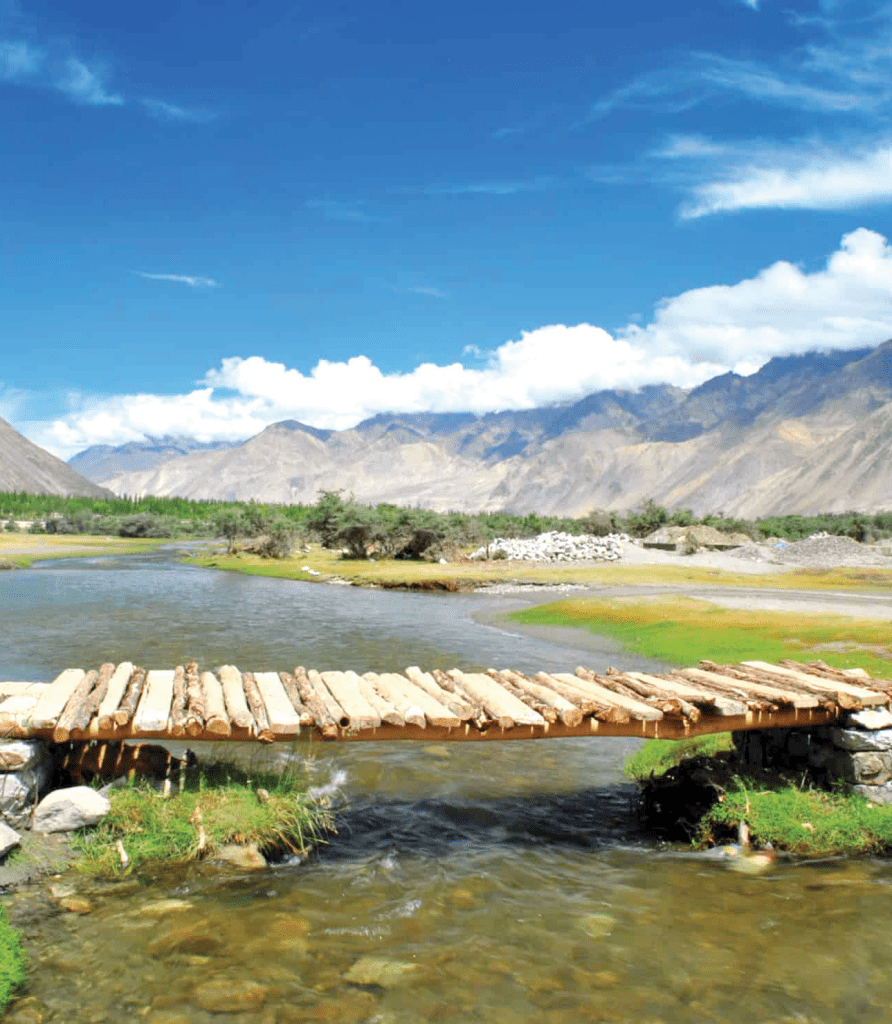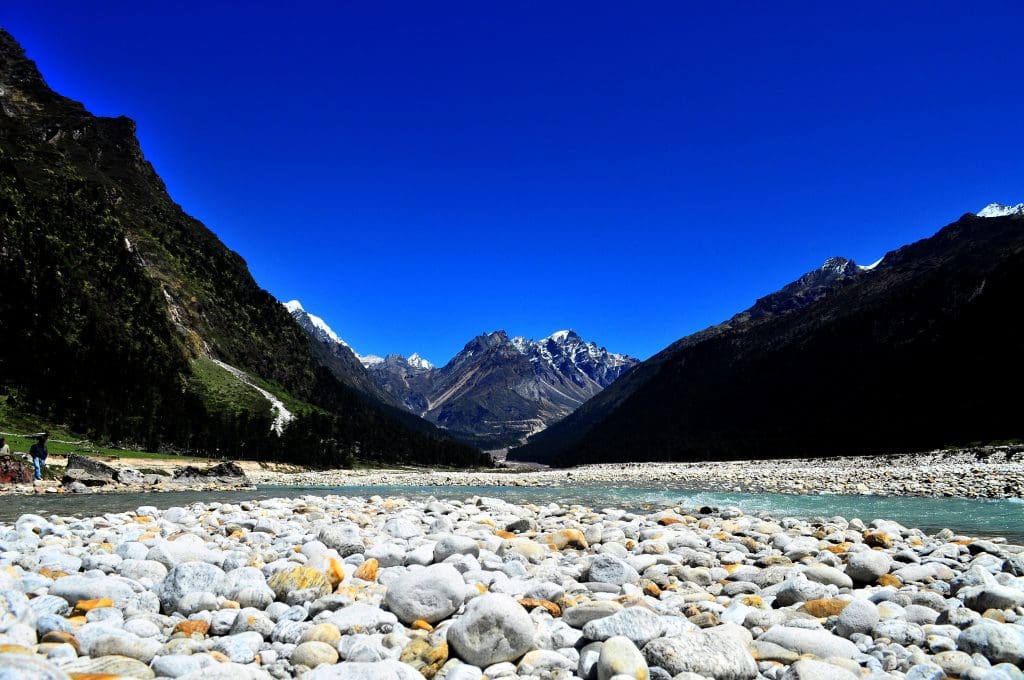We take you to some of the most picturesque valleys in India that will fill you with awe.
We remember the lofty mountains etched in the sky when we climb or trek their mighty slopes. Stop for a moment and remember the mind-numbing beauty of the lush meadows below.
Protected by the gigantic cold mountains, lie small settlements where life is slow, simple, and peaceful. The Himalayan mountains protect the soft green valleys from the cold Siberian winds preserving the lush green meadows and forests. These valleys are often referred to as sacred spots or spiritual sanctuaries on account of the pristine quality of nature and the very air you breathe in.
Just enjoying a cup of tea with the locals will fill you with euphoria. The children’s giggles will return your innocence. A stay experience in these valleys will remain in your heart, embedded in your memory forever.
We have put together a selection of the most picturesque valleys in India for your next summer trip.

Mana Valley, Uttarakhand
The pristine valley of the Nanda Devi Biosphere Reserve lies 47 km north of the village of Mana. The wonder of the Nanda Devi National Park and the incredible natural beauty of the Valley of Flowers National Park, which lies between the mountain ranges of the Zanskar and Great Himalaya are World Heritage sites that will blow your mind. Their untouched lustre remains intact because it is so difficult to reach here Together they create a unique transition zone.
The Mana village, in the valley, holds great significance in Hindu folklore as it is where Maharishi Vyas portrayed the epic of Mahabharata to the god Ganesha. The sacred Badrinath Shrine, one of the holiest pilgrimage places is simply 3 km away from the Mana Village. The Mana Valley likewise holds the source of the longest feeder of the Ganges, the Alaknanda River.
The Mana Village is referred to as the last town of India. The Mana La Pass on the border between India and Tibet is the most noteworthy open pass on the planet at 18,192 ft. It is from Mana La that you start the climb to Chaukhamba Peak.
Don’t miss a visit to the two famous caves of Mana – Vyas Gufa and Ganesha Gufa. Other stunning attractions that will take your breath away are Vasundhara Falls, Satopanth Lake and Bhim Pul.
Dzukou Valley, Nagaland
One of the most beautiful valleys of Nagaland is the Dzukou Valley which lies on the boundary of Manipur and Nagaland. The whole valley is a natural wonder because of its amazing topography which is a result of millions of years of nature’s erosion. The undulating meadows full of wildflowers are picturesque as they stretch as far as the eye can see. The verdant glens and knolls, meandering rivulets and soft flow of gentle hillocks present a captivating sight.

The Dzukou valley is covered with snow in winter and in summer it gives way for wonderful blossoms to sprout and cover the entire valley giving it an amazing beauty. There are two primary streams in this valley which is the Dzukou waterway and the Japfu waterway.
The valley alongside it is filled with delightful glades of blossoms and is known as the ‘Valley of Flowers of the North East.’ The valley is cherished as nature’s pristine cradle by wanderers in search of solitude and meditation amidst nature. On the other hand, some of its higher slopes are considered a paradise for trekkers who walk through wildflowers and brooks,
Parvati Valley, Himachal Pradesh
The ethereally beautiful Parvati valley is in Kullu Manali extending from Bhuntar right to Spiti. There are simply so many stunningly beautiful spots that can be visited making this valley one of the most sought after in India.

The snake formed cascade called Rudra-Nag, the evergreen pine timberlands of Khirganga said to be the contemplation spot of Lord Shiva, and above all ‘The Pin Valley National Park’, which is renowned for its populace of the snow panther – are all wonders of nature at its untouched best. The Pin Valley National park is located in the cold desert area of Lahaul & Spiti of Himachal Pradesh.
The remarkable natural beauty of this area has given birth to many legends, which circle around the god Shiva and goddess Parvati who found the untouched scenic beauty so breathtaking that they stayed here for 1100 years. The holy site of Manikaran at a height of 1760 m, attracts pilgrims from all over the country who bathe in the natural hot springs found here.
A little-known charming village in the beautiful valley is called Malana whose inhabitants are believed to be descendants of Greek soldiers of Alexander the Great and the good-looking locals have facial features that resemble the Romans.
Rock climbing on the higher slopes and trekking through the powder green meadows of the valley are a visitor’s joy. Fishing in the rippling clean fresh waters of the brooks and small rivers requires consent from the Forest office.
Spiti Valley, Himachal Pradesh
Rudyard Kipling described Spiti as a world within a world – where gods live. This rare landscape is so surreal that it is described as a moonscape with crystal clear Himalayan lakes and ancient monasteries dominating the higher grounds. If one has not visited Spiti, one can only imagine its untouched splendour.

The Valley of Spiti is situated in the middle of the captivating districts of Ladakh and Tibet. Here is a fascinating cold desert, untamed land of spiritualism, soothing valleys, and quiet villages amidst high windswept mountains.
The best and ideal time to visit the Spiti Valley is from the period of May to October. The tall mountains belong to the ranges of the Great Himalayas. This valley in India is well known for its surrounding snow-clad mountains, flawless cloisters, lovely lakes, and glacial masses.
The cold desert valley of Spiti is famous for the 1,015-year-old Tabo monastery at an incredible height of 10,000 ft. This rare mud brick Buddhist monument has ancient caves which are meditation centres, ancient frescos, statues, and mural paintings. It has been nominated for UNESCO’s World Heritage list.
Locals in Spiti for the most part follow Buddhism and Spiti is often called the ‘place that is known for the Lamas’, or Buddhist priests.. Spiti valley has similar vegetation and environment as Tibet and is consequently given the name ‘Little Tibet’. The valley of Spiti is home to numerous wild animals, particularly the Himalayan fox, the Himalayan Tahr, snow panthers, musk deer and is viewed as close to paradise as possible by wildlife photographers, artists, and spiritual seekers, and nature lovers.
Kangra Valley, Himachal Pradesh
The Kangra Valley is a lovely river valley in the mountain region of Himachal Pradesh which is covered with delightful pine tree backwoods, plantations, undulating green meadows, and clear, gurgling cold streams that descend from the Himalayas.

The valley faces winter from October to March so the best time to visit this delightful valley is during March end and April when the mid-year sun starts to sparkle showing the wonderful views of the Kangra Valley. The most spellbinding sight is the astonishing view of an almost vertical incline of the Dhauladhar range shooting up to a height of 15,956 ft. The black granite rock formations rising to high snow-covered jagged peaks are awe-inspiring.
The valley is additionally home to the ancient Kangra Fort, the magnificent rock-cut temple – Masroor Rock-cut Temple and the heritage village of Pragpur, founded in the 16th century with Mughul gardens, terraces, and water pools. The splendid natural landscape of the valley together with the rare Kangra Fort and Masroor Rock cut temple has been nominated for UNESCO’s World Heritage list. The locals handcraft exquisitely designed shawls and create the world-famous Kangra school of miniature paintings.
Nubra Valley, Jammu and Kashmir
Imagine a riot of orchards, panoramic vistas, Bactrian camels, and ancient monasteries – and you have a wonderous valley surrounded by the snow-covered Himalayan range. This is the Nubra Valley, situated in the higher regions of Jammu and Kashmir and also known as Ldumra which means the valley of flowers. The picturesque wide and flat Nubra valley is crisscrossed by the winding channels of the Shyok and Nubra Rivers and is thus home to fertile plains which make for prime orchards for which it is famous.

The best time to visit the valley is during the months of July to September when the temperature is pleasant and the valley orchards are in full bloom.
The excursion to Ensa, Samstemling, Diskit, and Hunder Buddhist monasteries is fascinating. The cold desert moonscape in winter and green flatlands in summer between Diskit and Hundur is a major novelty for tourists. The cold desert with the surreal sand dunes is a splendid sight.
Riding the Bactrian camels, with their two humps in the cold desert scape makes for an adventurous experience as it feels like another world. These camels are also significant as they point to the importance of the fertile Nubra Valley as an important trade stopover on the ancient Silk Route. Even today, the valley is famous for its Pashmina wool textiles as well as its fruit produce of apples, apricots, almonds, and walnuts among crops.
Valley of Flowers, Uttarakhand
The valley of flowers in Uttarakhand lies in the Chamoli region and holds an unbelievably lovely setting with rare and exotic Himalayan flora in front of the Zanskar ranges. The valley is known as the Valley of Flowers Indian National Park and is a UNESCO World Heritage Site.
The valley stays shrouded in snow throughout the cold weather months. In summer, it transforms into a paradise with its endemic Alpine flower-covered meadows along with blossoms of every kind. The valley is a picturesque panorama of clear, little streams, elegant knolls, gentle waterfalls and cascades, wildlife, and meadows that stun visitors in their abundance.
This spectacular valley is spread over an area of 87 sq km in the Chamoli district. The entire landscape is covered with exotic blossoms with over 600 flower species. This botanical paradise has primulas, marigolds, orchids, poppies, daisies, and anemones to name a few. The park is bordered by rich alpine forests, birch, and rhododendrons which lend further exotica to the park wonderland.
The valley has remained in pristine shape on account of its inaccessibility. The trek to the Valley of flowers finds its way through thick forests, along the Pushpawati river, crossing several bridges, waterfalls, and glaciers along the way. The best time to visit the valley is during the months of March to October.
Ziro Valley, Arunachal Pradesh
Included in the Tentative List for UNESCO’s World Heritage Site for the Apatani cultural landscape, Ziro valley in Arunachal Pradesh is a stunning valley destination known for its rare beauty of terraced paddy fields. Apart from an unmatched natural scenic beauty, the tranquil town of Ziro is known for its unique tribal heritage which attracts sociologists and anthropologists.

It is hidden away in the vast mountain-scape of Arunachal Pradesh and yet its natural beauty is so special that people have found their way here, discovered and explored its sprawling rice fields, ancient village culture, and green rolling hills enveloped in lush, vibrant flora.
The scenic little hill hamlets, its lush green terraced rice fields, and picturesque trails through tall pines and bamboo forests make it one of the most photographed valleys across the country. While the peace and tranquillity make it a spiritual paradise, its remarkable natural beauty attracts nature lovers, trekkers, artists, meditation seekers, and photographers who come here to soak in the splendour.

Ziro valley is also home to the ‘Talley Wildlife Sanctuary’ which has the elusive clouded leopards among other wildlife. Apart from the Talley Valley Wildlife Sanctuary, visitors can experience a trek to the Meghna Cave Temple, Kile Pakho, Miley, and Ziro Puto.
The valley is great for adventure seekers too. Sports like paragliding, bungee jumping, and stream boating are popular. The popularity of the ‘Ziro Music Festival’ put this charming hill town and valley on the map of every music lover.
Yumthang Valley, Sikkim
The picturesque Yumthang valley in Sikkim is a unique rhododendron sanctuary with more than 24 types of blooms from March to mid-June and is home to the Shingba Rhododendron Sanctuary, The Yumthang valley is situated in Sikkim at a height of 3564 m, just above the tree line. There is a natural aquifer on the right half of the Yumthang River from where the valley gets its name.
The scenic valley is naturally endowed with lush scented meadows blooming with a rainbow carpet of Himalayan flowers – with rhododendrons, poppies, iris, primulas, and other flora. The beautiful valley echoes the gushing waters of the Teesta river, hot springs, birdlife, and yaks grazing on rolling hillock pastures. No wonder, it is also called the Valley of Flowers.

During the spring the valley blossoms with a million flowers and in winter the snow-covered slopes give it a magical quality so loved by skiers. The valley is popular with anglers because of the well-stocked rivers of Yumthang chu and Puniya chu.
The Yumthang Hot Spring is well known for its medicinal value on account of its rich sulfur content and visitors come to take a dip in the warm waters even in the winters. Another attraction is the famous Shiva Temple. The valley is the starting point for trekkers and climbers who want to scale the beautiful peaks of Panhunri and Shundu Tsenpa.
Silent Valley, Kerala

Silent Valley National Park is a beautiful nature reserve holding the last remaining rainforest of Kerala. The valley is situated in the North-eastern region of the Palakkad region in Kerala in the Western Ghats, one of the richest biospheres in the world. Silent Valley and the forests alongside represent pure ‘Ecological islands’, with a wide diversity of species and indigenous evergreen and semi-evergreen glades.
There is a soft quietness encompassing the Silent valley from where it gets its name. The valley houses numerous extraordinary plants including 110 types of orchids, 1000 types of blossoms, 200 types of butterflies, and 400 types of moths. This makes the valley a nature’s paradise for vacationers.
There is a soft quietness encompassing the valley from where it gets its name. The valley houses numerous extraordinary plants including 110 types of orchids, 1000 types of blossoms, 200 types of butterflies, and 400 types of moths. This makes the valley a nature’s paradise for vacationers.
Read More: Latest



